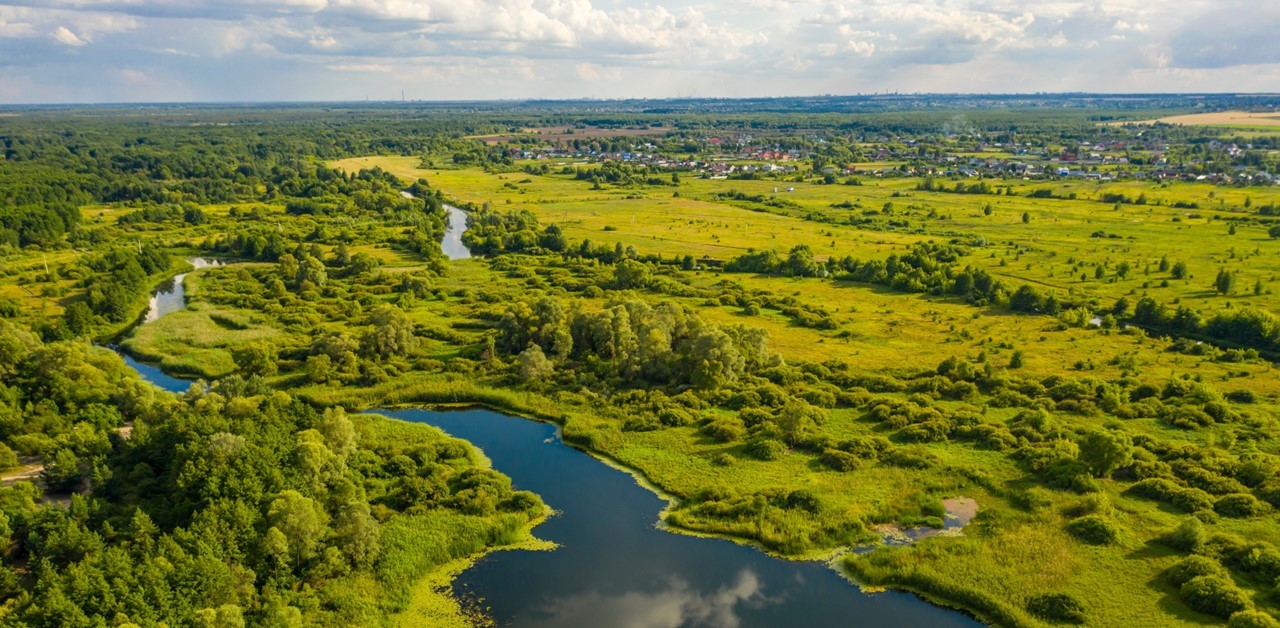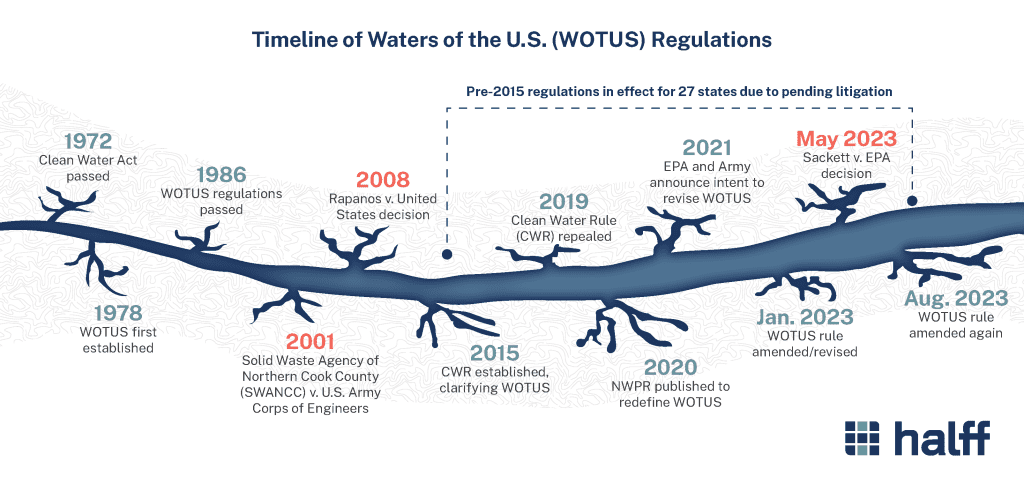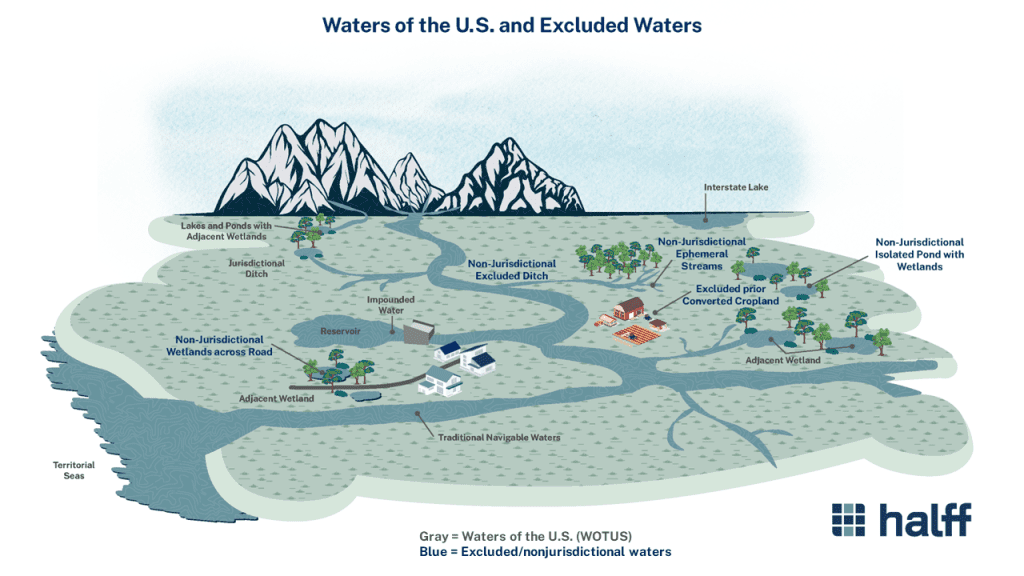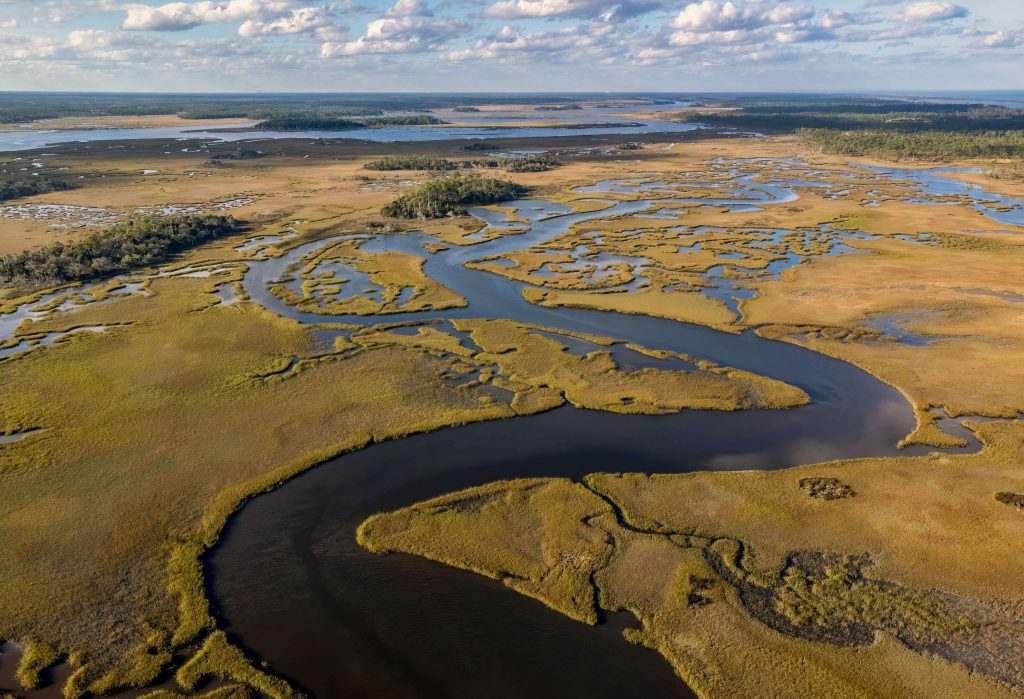Clearing the Murky Waters: Waters of the U.S. Definition Updates 2024
The term “Waters of the United States” (WOTUS) defines which waterbodies fall under federal protection through the Clean Water Act. Navigating this regulatory landscape can be a murky and frustrating experience, particularly with recent changes and ongoing legal challenges.
Keep reading to learn more about the current state of WOTUS, the areas of clarity and confusion, and how to wisely proceed when facing permitting struggles.
Jump to Section
A Brief History
The definition of WOTUS has undergone a roller coaster ride of revisions and legal battles.
The Clean Water Act (CWA) was enacted into law in 1972, following several federal court cases which required the EPA and USACE to refine the legal definition of WOTUS. The 2006 Rapanos v. United States Supreme Court case established the “significant nexus” standard for WOTUS. This standard served to form the modern basis of CWA jurisdiction; however, the standard was not easily definable and led to a patchwork of interpretations.
In an attempt to solidify the interpretation of WOTUS, the Obama administration promulgated the 2015 Clean Water Rule and developed an expansive definition of WOTUS for streams, wetlands and other water bodies. The 2015 Clean Water Rule was stayed almost immediately following publication, returning policy to the “significant nexus” standard.
In 2020, the Trump administration published the Navigable Waters Protection Rule, which narrowed the definition of federally protected waters, removing certain wetlands and smaller bodies of water from federal jurisdiction. However, it faced legal challenges, again reverting the definition to the pre-2015 standard.
The Biden administration developed the “Revised Definition of ‘Waters of the United States’” in 2023, officially restoring the pre-2015 standard. However, the published rule was revised in September 2023 to ensure conformance with the Supreme Court’s decision in the Sackett v. EPA case.
This complex history leaves many wondering, “What can we know for sure?”
Areas of Clarity
There are waterbodies that one can confidently identify as WOTUS that fall under the CWA’s protection. Namely, these include the following waterbodies:
-
- Traditional navigable waters (TNW) used or usable for commerce (e.g. rivers and lakes)
- Territorial seas
- Interstate waters
- Impoundments of waters otherwise defined as WOTUS (e.g. artificial lakes and reservoirs)
- Tributaries of TNW and impoundments that are relatively permanent, standing or continuously flowing
Map showing waterbodies identified as Waters of the United States (WOTUS) and excluded/nonjurisdictional waters. (Image created by Halff, derived from the EPA.) Click to enlarge.
In September 2023, the revised rule kept the following under WOTUS protection:
-
- Traditional navigable waters
- Tributaries only with a “significant nexus” to traditional navigable waters
- Adjacent wetlands with a “continuous surface connection”
Did you know? The revised September 2023 rule change excluded many headwaters, smaller streams and isolated wetlands.
The following bodies of water are not considered WOTUS:
-
- Most isolated wetlands
- Most ephemeral streams
- Most ditches
Areas of Confusion
Not all waters fall into clearly defined categories. Confusing areas emerge with smaller, less permanent features such as ephemeral streams and certain adjacent wetlands.
The definition of “continuous surface water connection” in these cases remains ambiguous, causing delays and headaches for project developers and landowners.
The following waterbodies are uncertain, and may or may not be considered “Waters of the United States,” depending on the case and location:
-
- Adjacent wetlands with a continuous surface connection to WOTUS
- Streams that are not identified as “relatively permanent”
What’s Next? It’s important to note that the future of the September 2023 rule is uncertain, as it’s currently facing legal challenges. Some courts have blocked it while others have upheld it.
Florida: A Case of Complicated Layers
The situation in Florida serves as a stark reminder of the complexity of WOTUS interpretations.
In a court decision issued Feb. 15, 2024, a federal judge has now removed the state’s authority to issue State 404 Program permits in Florida. As a result, all federal permitting activity for WOTUS under the State 404 Program is currently paused, while FDEP appeals the decision and until further order from the court. This decision affects pending permits, and has significant implications for development and conservation efforts in Florida. While awaiting further action in the coming months, stakeholders should stay informed and be prepared to adapt to changes in the regulatory landscape.
This underscores the importance of understanding the specific regulatory landscape in your jurisdiction. The EPA and Corps exercise authority to develop rules; however, until recently the State of Florida assumed permitting authority for Section 404 of the CWA. Each state and jurisdiction has varying complexity. It is a nationwide law, but the execution of Section 404 of the CWA may vary substantially depending on the location and configuration of aquatic features.
What We’re Doing & Recommending
By beginning with areas we know are jurisdictional, we can better strategize and work around uncertain waterbodies to prevent costly project delays. While waters that are not relatively permanent or directly connected will remain uncertain, avoiding these areas of confusion can mitigate risk as the permitting landscape becomes more clear.
While the WOTUS landscape remains murky, here are some recommendations:
-
- Seek expert guidance: Consulting environmental professionals with local experience can help you understand specific regulations and assess potential impacts that may require consideration.
- Minimize and avoid impacts: Prioritize project designs that minimize or avoid impacts on potentially protected waters.
- Embrace the risk-evaluation approach: Be prepared to be risk-averse. Adapt your plans based upon site-specific conditions to help reduce permitting risks and mitigation costs.
- Communicate effectively: Clear communication with regulatory agencies and stakeholders can help smooth out the permitting process.
A Positive Outlook: A Call for Patience and Progress
Time is money, but patience is key. Increased scrutiny and legal challenges hold the potential to refine the definition of WOTUS, and the Corps districts are continuing to develop guidance. By staying informed, adapting to changes and working collaboratively with experts, we can navigate these murky waters using careful judgment and risk-management strategies.
Hear from Halff Experts:
-
- How long will the jurisdictional process be? “It all depends upon the extent of the impacts, and the Corps’ approval of delineations and permitting. When we do delineation, we identify whether it is considered a wetland or not. We also look at a schedule to minimize and avoid risks. There is a need to take a risk-evaluation approach and be conservative sometimes.”
For the latest information on the WOTUS rule changes beyond 2023, please refer to news updates and reliable sources. Below are some helpful resources:
EPA’s WOTUS website
EPA: About Waters of the United States
EPA: Definition of “Waters of the United States”: Rule Status and Litigation Update
Need help navigating WOTUS uncertainty? Our talented environmental professionals bring years of WOTUS expertise to help you reduce risks and keep your projects moving forward.
Let Halff help you navigate by contacting Environmental Team Leader Chris Sanderson (cSanderson@halff.com), Environmental Team Leader (FL) Drew Sanders (Drew.Sanders@halff.com) or Environmental Technical Leader Rick Howard (rHoward@halff.com)









